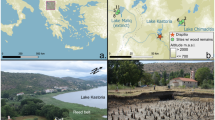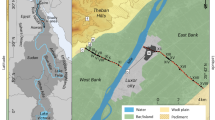Abstract
OUR understanding of the vegetational history of Britain is based mainly on studies of peat-bogs, lake and kettlehole infills1: away from areas where such deposits exist, there is a paucity of information2. A multidisciplinary investigation of a deposit associated with a Mesolithic site on Hampstead Heath, North London, is providing rare evidence about man's effect on the vegetational succession of south-east England. The pollen spectrum indicates that Tilia rich forest existed until the elm decline, followed by continuing clearance episodes and heath formation. Seeds and beetle remains, which provide more precise information on local conditions, confirm the overall pattern of change from natural forest to cleared areas used for cultivation and grazing. The Mesolithic site of West Heath, Hampstead (TQ2566 8676), is being excavated by the Hendon and District Archaeological Society under the direction of Mr D. Collins3. The site stands on dry, acid Bagshot Sands, but environmental investigations have been carried out at West Heath Spa, a boggy area about 300 m to the south-east, where permanent waterlogging is maintained by a chalybeate spring. At this spot, samples for pollen, seed and insect analyses were collected at 5-cm intervals from below the modern root layer to a depth of 130 cm. Results of these studies are briefly described here.
This is a preview of subscription content, access via your institution
Access options
Subscribe to this journal
Receive 51 print issues and online access
$199.00 per year
only $3.90 per issue
Buy this article
- Purchase on Springer Link
- Instant access to full article PDF
Prices may be subject to local taxes which are calculated during checkout
Similar content being viewed by others
References
Godwin, H. The History of the British Flora (Cambridge University Press, Cambridge, 1975).
Birks, H. J. B., Deacon, J. & Peglar, S. Proc. R. Soc. B 189, 87–105 (1975).
Lorrimer, D. H. Lond. Arch. 2, 407–409 (1976).
Kelly, M. & Osborne, P. J., Proc. Linn. Soc. Lond. 176, 37–65 (1974).
Allen, A. A. Entomol. Mon. Mag. 105, 245–249 (1969).
Duffy, E. A. J. Scolytidae and Platypodidae, Handbooks for the Identification of British Insects. R. Entomol. Soc. Lond. (1953).
Rackham, O. Trees and Woodland in the British Landscape (Dent, London, 1976).
Author information
Authors and Affiliations
Rights and permissions
About this article
Cite this article
GIRLING, M., GREIG, J. Palaeoecological investigations of a site at Hampstead Heath, London. Nature 268, 45–47 (1977). https://doi.org/10.1038/268045a0
Received:
Accepted:
Published:
Issue Date:
DOI: https://doi.org/10.1038/268045a0
Comments
By submitting a comment you agree to abide by our Terms and Community Guidelines. If you find something abusive or that does not comply with our terms or guidelines please flag it as inappropriate.



